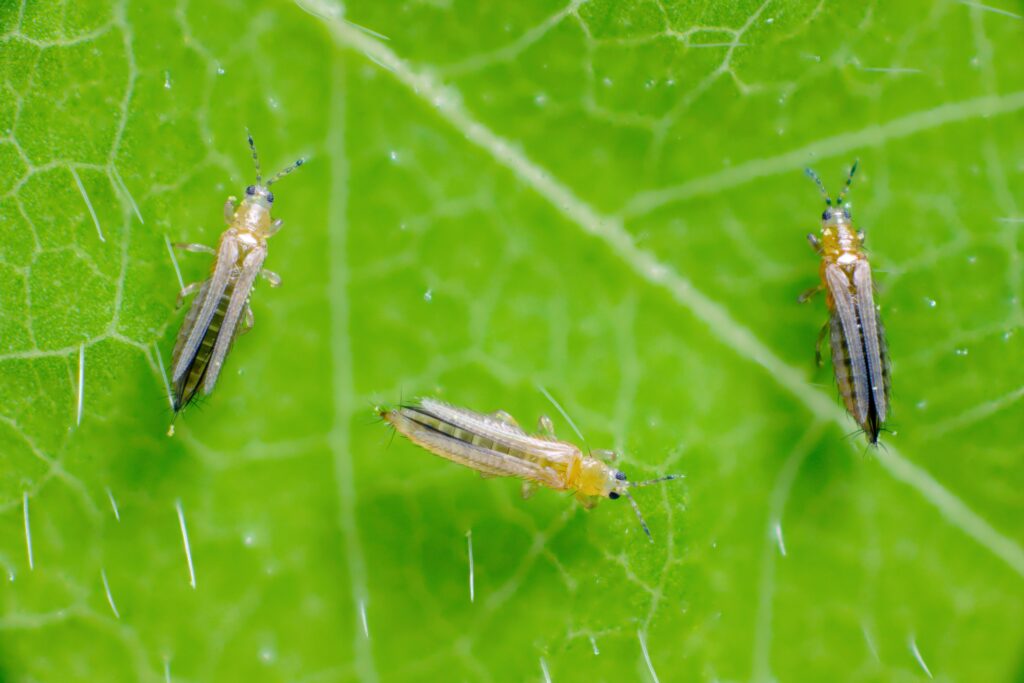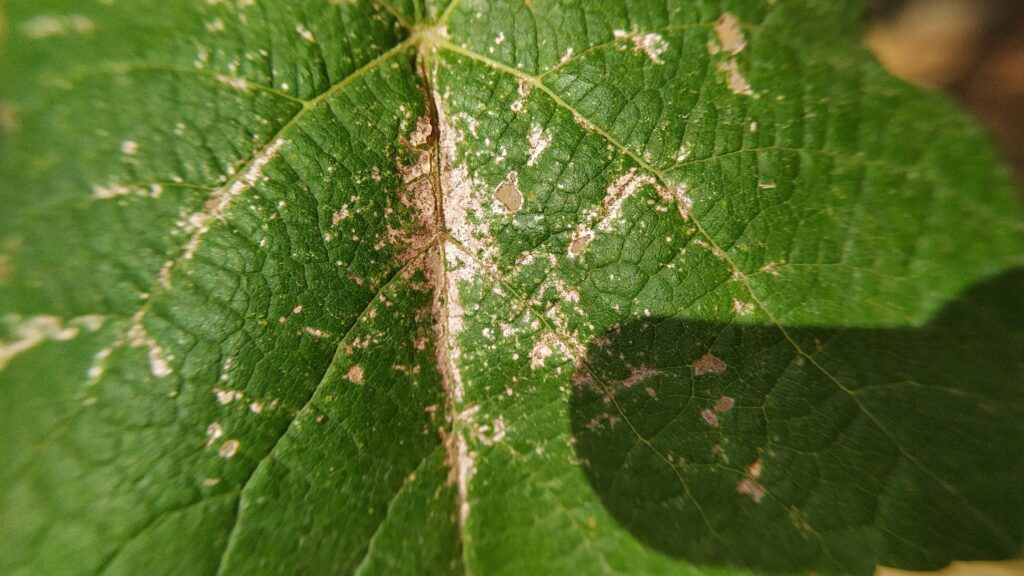Thrips Unveiled: Getting to Know the Miniature Troublemakers in Horticulture and Agriculture!
Thrips Management: Proven Control Strategies – PowerBugs Eco-Friendly Pest Management
Welcome to the PowerBugs knowledge hub, where we shed light on the intricate world of thrips – tiny yet significant pests that pose a considerable challenge in greenhouse horticulture. Among these, the Western flower thrips (Frankliniella occidentalis) stands out as the most damaging species. Let’s delve into the realm of Thysanoptera, exploring their characteristics, diversity, and the impact they can have on your crops.

Recognising Thrips Infestations
Identifying Thrips
Thrips, from the order Thysanoptera, are known for their fringed wings resembling delicate eyelashes. These pests range from 0.5 to 14 mm in length, with significant agricultural species belonging to the Thripidae family.
The cycle of thrips
Thrips undergo a fascinating life cycle:
- Egg Stage: Thrips hatch from eggs, initiating their transformative journey.
- Larval Stages: Thrips develop through two actively feeding larval stages.
- Nonfeeding Stages: After the larval stages, thrips go through two nonfeeding stages – the prepupa and pupa. Late-instar larvae undergo significant changes in appearance and behavior, transitioning into prepupae and pupae. It’s worth noting that thrips do not have a true pupal stage.
- Adult Stage: The final stage sees the emergence of the adult thrips, ready to continue the cycle through feeding, reproduction, and egg deposition.
Understanding this life cycle is crucial for effective pest management.
Thrips Lifecycle Duration and Adult Lifespan
The lifecycle of a thrips is approximately 21 days or less, especially in hot temperatures. Adult thrips live for 30-45 days, causing continuous damage to the plant parts they feed from. Females deposit eggs within plant tissues, contributing to the ongoing cycle of infestation.
Thrips pose a formidable challenge, but with PowerBugs, you have a partner in sustainable pest control. Explore our eco-friendly solutions to protect your crops and cultivate thriving, resilient greenhouse environments.
Thrips damage
- Visual Symptoms: Look for silver-grey patches and black excreta dots on leaves.
- Plant Health Impact: Thrips feeding can lead to chlorophyll loss, shriveled leaves, and distorted flowers.
- Virus Transmission: Notably, they can spread the tomato spotted wilt virus (TSWV) among crops.

Empower yourself against thrips infestations. Choose PowerBugs pest control products.
Preventing Thrips Infestations
Preventing Thrips Infestations
Protect your plants from thrips and their damaging effects with these tips:
- Regular Inspection: Check plants for thrips regularly to catch infestations early.
- Plant Health: Maintain proper watering and pruning practices to keep plants healthy.
- Isolation: Quarantine new plants and isolate infested ones to prevent spreading.
- Beneficial Insects: Introduce natural predators like cucumeris to control thrips.
- Reflective Mulch: Use reflective mulch to deter thrips from landing.
- Cleanliness: Keep the area around plants clean to eliminate hiding spots.
- Sticky Traps: Install blue sticky traps to capture adult thrips.
- Organic Sprays: Consider neem oil or insecticidal soap as preventive measures.
By following these steps, you can minimize thrips damage and ensure the well-being of your plants.
Our Solutions against thrips
Hypoaspis miles, Neoseiulus cucumeris
Featured Predatory Mites
Hypoaspis Miles and Neoseiulus Cucumeris: Effective in controlling thrips populations, available through our sustainable product range.
Don’t let thrips harm your precious plants. Contact PowerBugs today for expert thrips control solutions and keep your garden thriving.
Common Questions on Thrips
How can I identify thrips on my plants?
Thrips are small and can be difficult to see without magnification. Signs of their presence include stippling or silvery discoloration on leaves, deformed growth, and black fecal spots. You may also notice damaged flowers and fruits.
What kind of damage do thrips cause?
Thrips feed on plant cells, leading to discoloured, distorted, and scarred leaves, buds, and flowers. They can severely impact plant health, aesthetic value, and crop yield.
How do thrips reproduce and spread?
Many thrips species reproduce both sexually and asexually, laying eggs in plant tissue. They can spread rapidly through wind, infested plants, and human activity.
Can thrips transmit plant diseases?
Yes, thrips are vectors for several plant viruses, most notably the Tomato Spotted Wilt Virus and Impatiens Necrotic Spot Virus, which can cause significant damage to affected crops.
How can I prevent thrips infestations?
Preventive measures include regular monitoring of plants, removing weeds and plant debris, using reflective mulches to deter thrips, and introducing natural predators like predatory mites.
What are PowerBugs' solutions against thrips?
PowerBugs offers eco-friendly biological control options, including predatory mites such as Neoseiulus cucumeris and Hypoaspis miles, which are effective against various thrips species.
Are there any organic controls for thrips?
Organic control methods include using insecticidal soaps, neem oil, and introducing beneficial insects that prey on thrips, such as lacewings and predatory mites.
How can I manage thrips in a greenhouse setting?
In greenhouses, managing thrips involves rigorous sanitation, screening vents to prevent their entry, using sticky traps to monitor and reduce their numbers, and applying biological control agents.
How can I get more help with thrips control?
For personalised advice and effective thrips control solutions, contact PowerBugs directly. Our team of experts is ready to provide you with guidance on the most suitable products and practices for managing thrips in your specific situation.
GET IN TOUCH
Discover the Future of Agricultural Pest Control Solutions
At PowerBugs, we’re not just selling products; we’re offering a sustainable and eco-friendly solution to pest control. Join us in making a positive change in the world of agriculture. Explore our range of beneficial mites today and take the first step towards a greener and more prosperous future.
